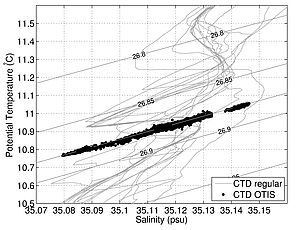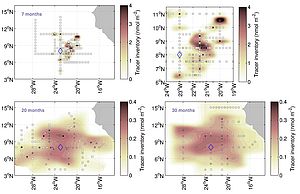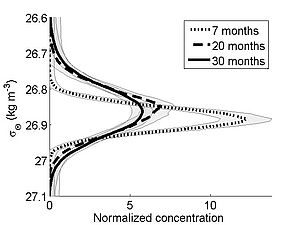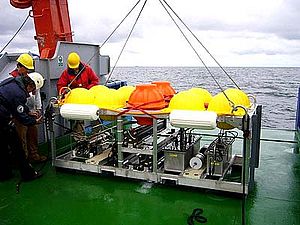The open ocean tracer release experiment is an accurate method to investigate the turbulent vertical mixing and horizontal dispersion in the ocean. The experiment starts with the release of a chemical compound, concentrations of which are detectable even when strongly diluted. With time, the tracer patch spreads horizontally and vertically, its spread monitored by several cruise campaigns.
Across the density surfaces, the tracer is displaced by many sporadic turbulent mixing events. The mean tracer patch thickness indicates the vertical mixing rate integrated over time and space and can be accurately estimated. In the mid-ocean common vertical mixing rates of 10-5 m s-1 is estimated with the accuracy of several percents.
Along the density surfaces, the spread of the tracer patch responds to the ocean's mean circulation and turbulent stirring by eddies. Hence, the horizontal dispersion and advection parameters can be inferred from the horizontal extent of the tracer patch, but less accurately than vertical mixing rate. The achieved accuracy of the method is turbulent stirring rates along the density surfaces is much worse than the accuracy of the vertical turbulent mixing rates. The common open ocean isopycnal dispersion rate of 102 to 103 m s-1 is estimated with the accuracy of several orders of magnitude.
GUTRE:
In 2008-2010 the tracer release experiment in the open ocean was performed in the tropical northeast Atlantic with the purpose to quantify the upper ventilation pathway of the oxygen minimum zone. The Guinea Upwelling Tracer Release Experiment (GUTRE) started by the release of the tracer, CF3SF5, on an isopycnal surface σθ= 26.88 kg m-3, which corresponds to about 350 m depth. Three surveys, performed 7, 20, and 30 months after the release, sampled the laterally and vertically expanding tracer patch. After 30 months the tracer patch expanded about 200 m in the vertical and more than 1000 km in the horizontal. The experiment resulted in the vertical mixing rate of (1.2 ± 0.1) ∙ 10-5 m s-1.
CF3SF5
Trifluoromethyl sulfur pentafluoride (CF3SF5) is detectable in quantities as low as 10-16 mol kg-1 in a seawater sample by a gas chromatograph with an electron capture detector. As an example, the common trace metals in the ocean, like iron, zink, is measured in the concentrations of 10-9 mol kg-1, oxygen in 10-6 mol kg-1. The compound CF3SF5 is virtually inert in the marine environment, i.e., it is a chemically conserved and it is and therefore harmless to marine organisms. The only known environmental impact of the substance is that it is a minor greenhouse gas.
Ocean Tracer Injection System (OTIS)
OTIS is an underwater sled used to release the tracer very close to one chosen density surface. The neutrally buoyant sled is equiped with the container of compressed tracer gas and CTD (conductivity-temperature density) instrument.
CTD locally controlls the sled position in the depth. When the sled deviates from the aimed density surface, the pumps injecting the tracer switch off.
During the operation, the sled is towed under the water with the ship speed of 1-2 knots for several hours. The tracer is released as a spray of small droplets, because they have to dissolve quickly to avoid sinking to the ground. The achieved density error of the tracer injection is less than 0.005 kg m-3, equivalent to a depth error of about 2 m.
The high accuracy of the tracer injection is required to accurately estimate the rate of the tracer patch widening over the density surfaces with time.






